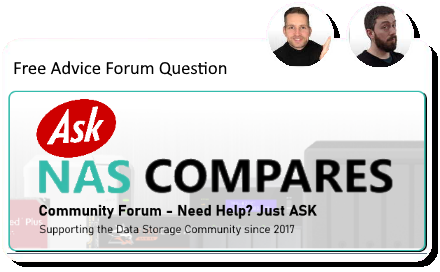
+- ASK NC (https://ask.nascompares.com)
+-- Forum: Q&A (https://ask.nascompares.com/forumdisplay.php?fid=1)
+--- Forum: Before you buy Q&A (https://ask.nascompares.com/forumdisplay.php?fid=2)
+--- Thread: Need help, not just with 1st NAS but a backup NAS as well. (/showthread.php?tid=12340)
Need help, not just with 1st NAS but a backup NAS as well. - Enquiries - 09-26-2025
Greetings NASCompares,
I came across your channel a few months ago while trying to learn more about what a NAS is and how to backup all of my personal data, both from my laptop and android phone. I can't afford what I consider to be my ultimate NAS system right now, so I'm going to try breaking this down into several steps. I'll have to space them out based on what I can afford.
1. I'm planning to start with getting a cheap qnap device just to use as backing up my laptops data
QNAP TS-233-US 2 Bay $200
Seagate IronWolf 8TB HDD $180
2. I'm considering a raspberry pi 5 and connecting a few nvme drives for the purpose of having my data saved to two different types of storage media.
3. Build my ideal NAS that can also be my entertainment/file server.
What the difference is between simple back up of my files and a system clone? Should I do both?
How do I prevent Bitrot?
What's the best way to encrypt my data? Are there any other security concerns?
RE: Need help, not just with 1st NAS but a backup NAS as well. - ed - 09-26-2025
Thanks for reaching out, and great to hear you’re planning this in stages — that’s a very smart way to approach it. Let me address each of your points:
1. Starting with the QNAP TS-233 and IronWolf 8TB: That’s a perfectly reasonable entry point. It’s a budget ARM-based NAS, so not powerful enough for heavy apps or Plex transcoding, but it works well for simple backups, file sharing, and mobile sync.
2. Raspberry Pi 5 with NVMe: This is a creative idea, but I’d view it as more of a side project than a reliable second backup. Pi-based systems can be great fun and useful for light services, but they lack the resilience, redundancy, and software polish of a dedicated NAS. For your second backup, it may be simpler to use an external USB drive or even cloud storage until you’re ready to build your “ideal” NAS.
3. Ultimate NAS later on: That’s the best plan. You’ll learn from the smaller setups and know exactly what you want when you invest in the bigger system for media and multiple services.
Now to your specific questions:
• Backup vs. Clone:
A backup means keeping copies of your important files. If the original is lost or corrupted, you still have another copy. A clone is an exact 1:1 copy of your entire system drive (including the operating system and programs). Backups protect your data, while clones let you recover a whole system quickly if the laptop dies. For most people, doing both is ideal: regular file backups plus occasional full system clones (using software like Macrium Reflect or Clonezilla).
• Preventing Bitrot:
Bitrot is the slow corruption of data over time. The best defense is using a filesystem with checksums and scrubbing, like ZFS or Btrfs (available on higher-end QNAP and Synology units). On a TS-233, you won’t have that, so the next best thing is keeping multiple copies of your files and occasionally verifying them with tools like hashdeep.
• Encrypting Data:
QNAP and Synology both support folder or volume-level encryption (AES-256). It’s easy to enable when creating shared folders. For sensitive data, enable encryption and store the keys securely. If you’re carrying portable drives, VeraCrypt is also a solid cross-platform option.
• Other Security Concerns:
• Avoid exposing your NAS directly to the internet. If you need remote access, use a VPN (WireGuard, OpenVPN, or Tailscale).
• Keep firmware and apps up to date.
• Set strong user accounts and disable default admin where possible.
• Use snapshots (if your NAS supports them) as protection against accidental deletion or ransomware.
So in short: your staged plan is good. Start small with the TS-233, don’t over-invest in the Pi, and keep your bigger build in mind for when you’re ready. Focus on multiple copies, encryption where needed, and safe networking.